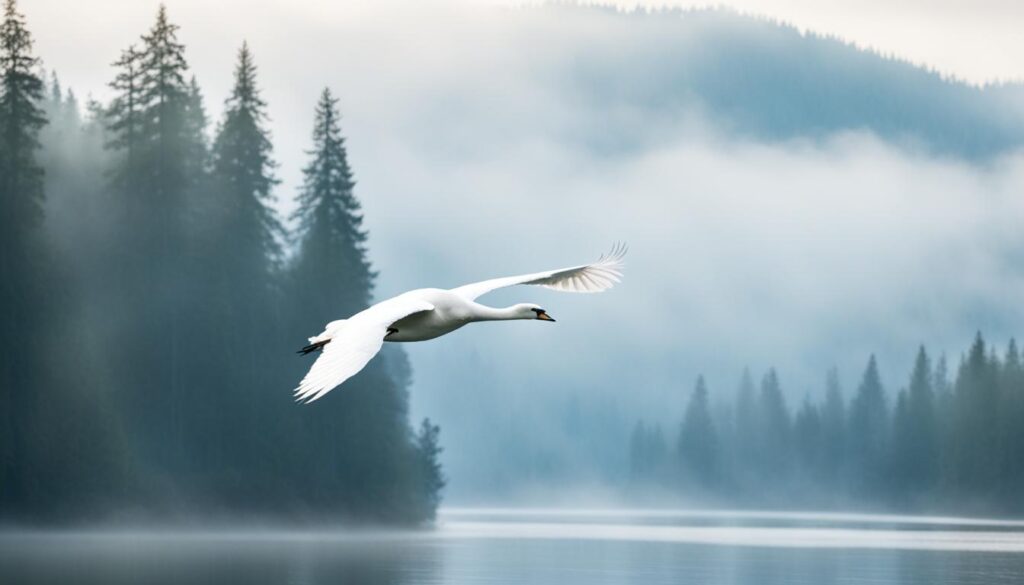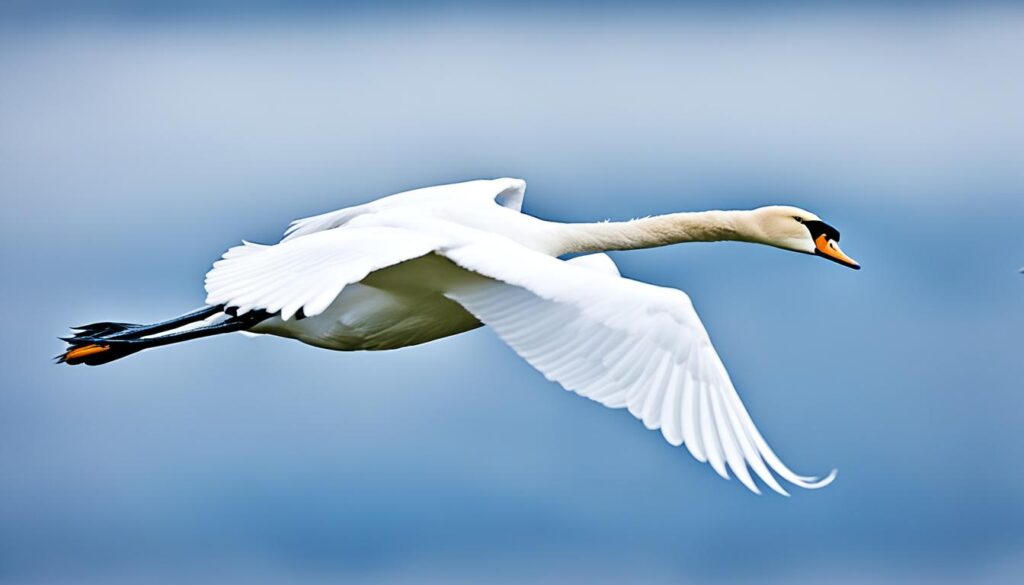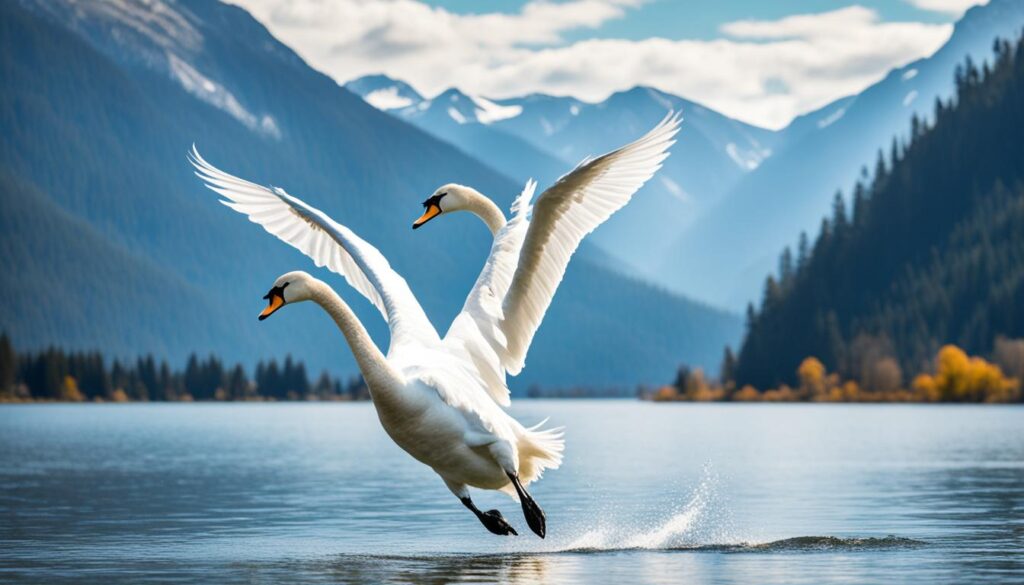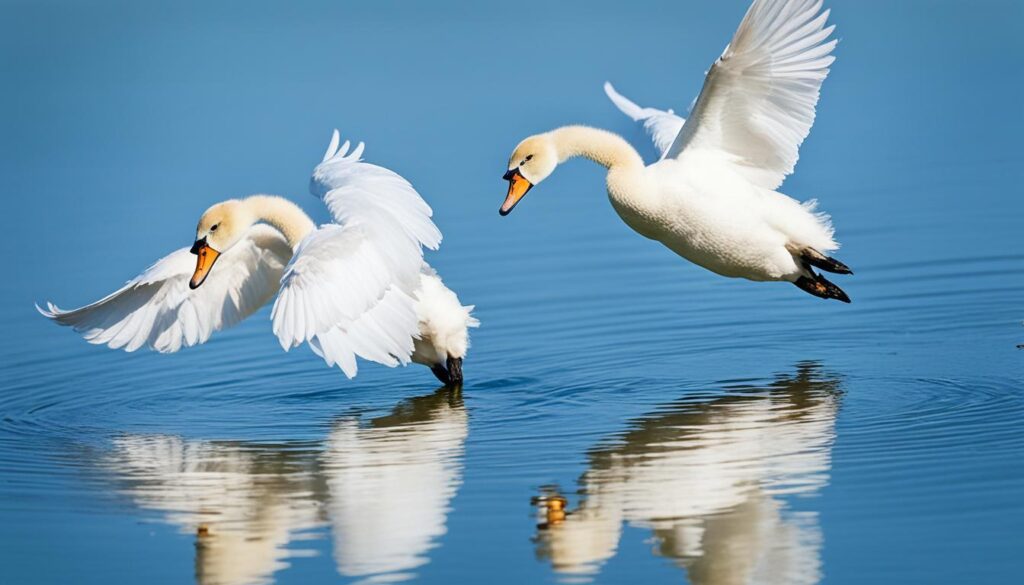Were you aware that swans, the elegant birds renowned for their beauty and poise, are not solely confined to gracefully gliding on water? Contrary to common belief, swans possess the impressive skill of soaring through the skies! In the following article, we will delve into the captivating realm of swans and uncover the enigmas of their flight.
Key Takeaways:
- All swan species are capable of flying, despite their large size and heavy bodies.
- Swans use their powerful wings to migrate, escape predators, and navigate their environment.
- Swan migration patterns vary among species, with some swans traveling thousands of miles in search of better food sources.
- Swans can reach impressive flying speeds and altitudes during their journeys.
- Young swans, known as cygnets, develop the ability to fly at around 4 to 7 months old.
The Flight Abilities of Swans
Despite their large size and heavy bodies, all swan species have the ability to fly. Swans can soar through the sky with powerful wings, allowing them to migrate to different locations in search of food and suitable breeding grounds. Flying also helps swans escape predators and navigate their environment more effectively.
Swans possess remarkable flight abilities that enable them to travel long distances and adapt to various habitats. Their wings, characterized by strong and sturdy feathers, generate the necessary lift to support their bodies in flight. This unique adaptation allows swans to take full advantage of their surroundings, exploring vast territories and seizing opportunities.

Swans maneuver through the air with impressive agility, showcasing their mastery over flight. Their wing movements, combined with their elongated necks and outstretched legs, create an iconic image of elegance and beauty. Whether gracefully gliding above still waters or propelling themselves through the sky in search of new horizons, swans command attention and leave us in awe of their flight capabilities.
“Swans are adept flyers, defying the expectation that their size would hinder their ability to take flight. Their majestic presence in the air is a testament to their adaptability and strength.”
Observing a majestic swan in flight is a breathtaking experience. As they soar gracefully above, we witness nature’s harmonious blend of power and grace. Swans make use of the air currents and thermals to achieve lift and sustain their flight, effortlessly gliding through the sky with minimal effort.
The flight abilities of swans are not limited to their physical characteristics and capacity for flight. The act of flying serves a vital purpose in their survival and reproduction. Migratory swan species take advantage of their flight capabilities to embark on extensive journeys in search of better resources and more favorable environments. These migratory patterns ensure their continued survival and promote genetic diversity among swan populations.
The migration of swans is a remarkable phenomenon, with entire flocks of these magnificent birds traversing great distances. They navigate challenging terrains, cross vast bodies of water, and adapt to changing weather conditions with astonishing precision. Flying allows swans to explore diverse habitats, find optimal foraging grounds, and secure suitable nesting sites.
The Significance of Swan Flight Abilities
The flight abilities of swans extend beyond their practical advantages. Their graceful flights captivate our imagination, serving as a symbol of freedom and transcendence. Swans inspire us to reach for the skies and embrace our own inner potential.
A Comparison of Swan Flight Abilities
The table below provides a comparison of different swan species and their flight characteristics:
| Swan Species | Wingspan | Flight Speed | Migratory Behavior |
|---|---|---|---|
| Mute Swan | 6.5 to 8 feet | 30 to 40 mph | Non-migratory or short-distance migration |
| Trumpeter Swan | 7 to 8 feet | 40 to 50 mph | Long-distance migration |
| Whooper Swan | 7.5 to 9 feet | 40 to 50 mph | Long-distance migration |
| Tundra Swan | 5 feet | 30 to 40 mph | Long-distance migration |
| Black Swan | 5 to 6 feet | 20 to 30 mph | Non-migratory or short-distance migration |
Swan flight abilities vary between species, and their wingspan, flight speed, and migratory behavior differ accordingly. While mute swans are largely non-migratory and adapt to colder climates, trumpeter swans and whooper swans undertake impressive long-distance migrations. Tundra swans also exhibit similar migratory patterns, while black swans tend to have non-migratory or short-distance migration behavior. Regardless of their specific flight characteristics, all swans possess the innate ability to take flight and gracefully navigate the skies.
Which Swans Can Fly?
All swan species, including mute swans, trumpeter swans, whooper swans, tundra swans, English swans, and black swans, are capable of flying. While some swans are non-migratory and stay in one area year-round, others migrate south in the winter to avoid cold weather and find better food sources.
Mute swans, known for their elegant beauty, are widespread in North America and Europe. They are mostly non-migratory and can adapt to a range of climates, including colder regions.
Trumpeter swans, the largest North American swans, are known for their loud and distinctive calls. They undertake long-distance migrations, flying from their breeding grounds in northern regions to wintering areas in the south.
Whooper swans, native to Europe and Asia, are famous for their trumpeting call. These swans also migrate long distances, traveling thousands of miles from their breeding grounds in the Arctic to their wintering grounds in more temperate regions.
Tundra swans, as their name suggests, spend their breeding season in the Arctic tundra. They then migrate south to spend the winter along the coasts of the United States, Mexico, and other parts of North America.
English swans, also known as Bewick’s swans, breed in the Arctic regions of Russia and migrate to Western Europe for the winter. These swans exhibit a strong fidelity to their wintering sites and can often be seen in large flocks along the British coastline.
Black swans, native to Australia, also have the ability to fly. While they are not migratory, they can cover long distances in search of suitable habitats and food sources.
“All swan species, including mute swans, trumpeter swans, whooper swans, tundra swans, English swans, and black swans, are capable of flying.”
The Flying Swans: An Impressive Sight
Witnessing the flight of swans is a truly awe-inspiring experience. With their graceful movements and powerful wings, these birds effortlessly navigate the skies, showcasing their adaptability and survival skills.
During migration, swans often form V-shaped formations, allowing them to take advantage of aerodynamic benefits. By flying in a synchronized pattern, they reduce wind resistance and conserve energy, enabling them to cover vast distances in their search for food and suitable habitats.
| Swan Species | Flying Behavior |
|---|---|
| Mute Swans | Non-migratory, adapt to various climates |
| Trumpeter Swans | Long-distance migration between breeding and wintering grounds |
| Whooper Swans | Long-distance migration from Arctic breeding grounds to temperate wintering areas |
| Tundra Swans | Migrate from Arctic tundra breeding grounds to coastal wintering locations |
| English Swans | Migrate from Arctic Russia to Western Europe for winter |
| Black Swans | Non-migratory but can cover long distances within their range |
In addition to their regular flight patterns, some swans exhibit unique flight behaviors. The windsurfing behavior of mute swans, where they glide rapidly across the water’s surface, is a fascinating sight. Taking advantage of strong winds, they use their wings to “surf” on the water, conserving energy while traveling swiftly.

Swans are magnificent creatures both on land and in the air. Their ability to fly allows them to explore new territories, access better food sources, and escape potential threats. Whether they are soaring through the sky in a majestic line or windsurfing on the water’s surface, the flight of swans never fails to captivate and inspire. Stay tuned for the next section, where we delve deeper into the flight characteristics of swans.
Flight Characteristics of Swans
When it comes to flight, swans possess remarkable characteristics that allow them to navigate the skies with grace and efficiency. Let’s delve into some of their fascinating flight traits.
Swans are capable of reaching impressive flying speeds, with some flocks soaring at up to 50 miles per hour. With a tailwind, these majestic birds can even reach speeds of up to 70 miles per hour, showcasing their agility and strength in the air.
One notable behavior of swans during flight is their tendency to form V-shaped formations. This flight pattern serves a purpose beyond aesthetics. By flying in a V formation, swans reduce wind resistance, resulting in increased energy conservation during long-distance flights. This strategy allows them to sustain their journey and cover vast distances without tiring easily.
In addition to their speed and formation, swans display impressive altitude capabilities. These birds have been observed flying at various altitudes, ranging from just a few hundred feet above the ground to a staggering 26,500 feet. Such flexibility in altitude allows swans to adapt to different environments and navigate diverse landscapes during their migrations.

Swan Flight Characteristics Comparison
| Flight Characteristic | Mute Swan | Trumpeter Swan | Whooper Swan |
|---|---|---|---|
| Flight Speed (mph) | 45 | 50 | 55 |
| Typical Altitude Range (feet) | 500 – 3,000 | 1,000 – 4,000 | 1,500 – 5,000 |
| Migratory Behavior | Non-migratory | Migratory | Migratory |
Comparing the flight characteristics among different swan species provides valuable insights into their abilities. While the mute swan attains an impressive flight speed of approximately 45 miles per hour, trumpeter and whooper swans can reach even higher speeds, with the latter species soaring up to 55 miles per hour.
In terms of altitude range, mute swans typically fly at altitudes between 500 and 3,000 feet, while trumpeter swans have a wider range of 1,000 to 4,000 feet. Whooper swans exhibit the highest typical altitude range, flying between 1,500 and 5,000 feet. These altitude variations reflect the diverse habitats and migration patterns of each species.
Overall, swans showcase remarkable flight characteristics that enable them to navigate the skies and undertake their awe-inspiring migrations. Their speed, formation, and altitude capabilities exemplify the adaptability and strength of these magnificent birds.
Swan Migration
Swan migration patterns can vary depending on the species and their geographical locations. Some swans, like tundra and trumpeter swans, migrate south in the winter to find better food sources. Mute swans, on the other hand, are largely non-migratory and can adapt to northern climates. Swans can migrate thousands of miles, with whooper swans traveling up to 3,000 miles in a single migration.
| Swan Species | Migration Patterns |
|---|---|
| Tundra Swan | Migrates south in the winter |
| Trumpeter Swan | Migrates south in the winter |
| Mute Swan | Largely non-migratory |
| Whooper Swan | Migrates up to 3,000 miles in a single migration |
Understanding swan migration patterns is essential to studying their behavior and conservation efforts. These long-distance journeys allow swans to access better food sources and suitable wintering grounds. The ability to migrate over such vast distances showcases the adaptability and resilience of these remarkable birds.

Swan migration also plays a crucial role in maintaining ecological balance. As swans move between different regions, they help disperse seeds and nutrients, contributing to the health of various ecosystems along their migration routes. By studying and preserving swan migration patterns, we can protect these magnificent birds and the habitats they rely on.
Unique Flight Behaviors of Swans
In addition to traditional flying, swans exhibit unique flight behaviors that further showcase their adaptation and prowess in the air. One such behavior observed in swans is windsurfing. These magnificent birds have been spotted traveling at high speeds on the surface of the water with the help of strong winds. This behavior, known as windsurfing, allows swans to conserve energy and move swiftly without the continuous effort of flight.
This fascinating flight behavior demonstrates the resourcefulness and adaptability of swans when navigating their environments. By harnessing the power of the wind, swans can effortlessly glide across water surfaces, displaying a graceful and skillful interaction with their surroundings.

Flying Abilities of Young Swans
Did you ever wonder when young swans, known as cygnets, start taking flight? It’s fascinating to witness these adorable creatures grow and develop their flight abilities. Let’s delve into the details of when swan cygnets can fly and how they acquire their flight skills.
Typically, swan cygnets begin to develop the strength and skills required for flight at around 4 to 7 months old.
Before their wings can carry them through the air, cygnets rely on their fluffy down coat to float on water and stay warm. This fluffy down provides insulation, keeping them cozy during their early stages of growth.
As cygnets mature, their adorable downy feathers are gradually replaced by stronger flight feathers. These flight feathers play a vital role in enabling swans to take flight and soar through the skies.
Once cygnets gain their first flight feathers, they eagerly spread their wings and embark on their maiden flight. It’s an incredible milestone in their journey towards independence and adult life.
Joining their parents in flight is not only a thrilling experience for the young swans but also an essential step in their development. By flying alongside their parents, cygnets learn crucial navigation skills, foraging techniques, and the art of graceful flight.
Witnessing the young swans take their first flight is a delightful sight, filled with wonder and excitement. It’s truly a testament to the remarkable flight abilities of these magnificent birds.

Swan Cygnet Flight Development
| Age | Flying Milestone |
|---|---|
| 0-4 months | Reliance on down feathers for warmth and flotation |
| 4-7 months | Development of flight skills and strength |
| 7+ months | Maiden flight and integration into the flock |
Conclusion
Swans are truly amazing creatures when it comes to flight. Their ability to soar through the sky with grace and elegance is a sight to behold. Whether it’s the trumpeter swan with its powerful wings or the whooper swan embarking on incredible migratory journeys, these birds never fail to captivate us with their flight capabilities.
From flocking in V-shaped formations to reduce wind resistance, to flying at astonishing speeds of up to 50 miles per hour, swans showcase their adaptability and strength in the air. They navigate through the skies with precision, whether it’s finding better food sources during migration or escaping from potential predators.
So, to answer the question “Can swans fly?”, the resounding answer is yes. Swans have proven time and again that they are more than capable of defying gravity and taking to the skies. Their flight is a testament to their remarkable nature and adds to the allure and mystique surrounding these beautiful birds.










